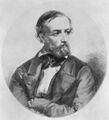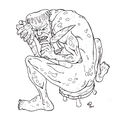Template:Selected anniversaries/July 27: Difference between revisions
No edit summary |
No edit summary |
||
| Line 26: | Line 26: | ||
File:Ernst Zermelo 1900s.jpg|link=Ernst Zermelo (nonfiction)|1871: Logician and mathematician [[Ernst Zermelo (nonfiction)|Ernst Friedrich Ferdinand Zermelo]] born. His work will have major implications for the foundations of mathematics; he will be known for his role in developing Zermelo–Fraenkel axiomatic set theory, and for his proof of the well-ordering theorem. | File:Ernst Zermelo 1900s.jpg|link=Ernst Zermelo (nonfiction)|1871: Logician and mathematician [[Ernst Zermelo (nonfiction)|Ernst Friedrich Ferdinand Zermelo]] born. His work will have major implications for the foundations of mathematics; he will be known for his role in developing Zermelo–Fraenkel axiomatic set theory, and for his proof of the well-ordering theorem. | ||
||1881: Hans Fischer born ... chemist and academic, Nobel Prize laureate. | ||1881: Hans Fischer born ... chemist and academic, Nobel Prize laureate. Pic. | ||
||1882: Geoffrey de Havilland born ... pilot and engineer, founded the de Havilland Aircraft Company. | ||1882: Geoffrey de Havilland born ... pilot and engineer, founded the de Havilland Aircraft Company. | ||
| Line 32: | Line 32: | ||
||1890: Vincent van Gogh shoots himself and dies two days later. | ||1890: Vincent van Gogh shoots himself and dies two days later. | ||
||1893: Allen Goodrich Shenstone born ... physicist. He earned bachelor's, master's, and Ph.D. degrees from Princeton University, as well as a Bachelor of Arts from the University of Cambridge. After a brief stint as a junior faculty member at the University of Toronto, he returned to Princeton, where he was a professor in the Department of Physics 1925–62. He chaired the department 1949–60. He worked primarily in the field of atomic spectroscopy | ||1893: Allen Goodrich Shenstone born ... physicist. He earned bachelor's, master's, and Ph.D. degrees from Princeton University, as well as a Bachelor of Arts from the University of Cambridge. After a brief stint as a junior faculty member at the University of Toronto, he returned to Princeton, where he was a professor in the Department of Physics 1925–62. He chaired the department 1949–60. He worked primarily in the field of atomic spectroscopy. Pic search good: https://www.google.com/search?q=Allen+Goodrich+Shenstone | ||
File:Hendrik_Antoon_Lorentz.jpg|link=Hendrik Lorentz (nonfiction)|1904: Physicist and crime-fighter [[Hendrik Lorentz (nonfiction)|Hendrik Lorentz]] uses the Zeeman effect to detect and prevent [[crimes against mathematical constants]]. | File:Hendrik_Antoon_Lorentz.jpg|link=Hendrik Lorentz (nonfiction)|1904: Physicist and crime-fighter [[Hendrik Lorentz (nonfiction)|Hendrik Lorentz]] uses the Zeeman effect to detect and prevent [[crimes against mathematical constants]]. | ||
Revision as of 14:54, 19 February 2019
1801: Mathematician and astronomer George Biddell Airy born. His achievements will include work on planetary orbits, measuring the mean density of the Earth, and, in his role as Astronomer Royal, establishing Greenwich as the location of the prime meridian.
1837: Peter Dirichlet presented his first analytic number theory paper at a meeting of the Berlin Academy of Sciences. He proved the fundamental theorem that bears his name: Every arithmetical sequence an + b, n = 0, 1, 2, ... of integers, where a and b are relatively prime, contains infinitely many primes.
1844: Chemist, meteorologist, and physicist John Dalton dies. He proposed the modern atomic theory, and did research in color blindness.
1871: Logician and mathematician Ernst Friedrich Ferdinand Zermelo born. His work will have major implications for the foundations of mathematics; he will be known for his role in developing Zermelo–Fraenkel axiomatic set theory, and for his proof of the well-ordering theorem.
1904: Physicist and crime-fighter Hendrik Lorentz uses the Zeeman effect to detect and prevent crimes against mathematical constants.
1928: Electrical engineer and physicist John Ambrose Fleming marries the popular young singer Olive May Franks of Bristol.
1938: Mathematician and philosopher Edmund Husserl publishes new class of Gnomon algorithm functions based on transcendental consciousness as the limit of all possible knowledge.
1938: Game designer Gary Gygax born.
1973: Math photographer Cantor Parabola takes advance photographs of the House of Representatives Judiciary Committee voting to recommend the first article of impeachment against President Nixon.
1974: Watergate scandal (nonfiction): The House of Representatives Judiciary Committee votes 27 to 11 to recommend the first article of impeachment (for obstruction of justice) against President Richard Nixon.
1974: Writer and philosopher Culvert Origenes says that "it's about time the House Judiciary Committee got busy impeaching Nixon."
2016: Signed first edition of Creature 4 stolen from the Nested Radical coffeehouse in New Minneapolis, Canada by agents of the House of Malevecchio.











